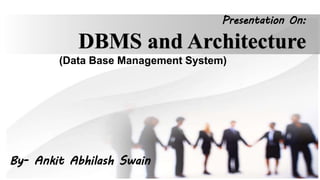
Data base management system and Architecture ppt.
- 1. Presentation On: DBMS and Architecture (Data Base Management System) By- Ankit Abhilash Swain
- 2. What is DBMS? • Database – is collection of related data and its metadata organized in a structured format – for optimized information management • Database Management System (DBMS) – is a software that enables easy creation, access, and modification of databases – for efficient and effective database management • Database System – is an integrated system of hardware, software, people, procedures, and data – that define and regulate the collection, storage, management, and use of data within a database environment
- 3. Database Management System (DBMS)
- 4. Types of DBMS There are four structural types of database management systems: • Hierarchical databases • Network databases • Relational databases • Object-oriented databases
- 5. Hierarchical Databases • In the Hierarchical Database Model we have to learn about the databases. It is very fast and simple. • In a hierarchical database, records contain information about there groups of parent/child relationships, just like as a tree structure. • It collects all records together as a record type. These record types are the equivalent of tables in the relational model, and with the individual records being the equivalent of rows.
- 6. Network Databases • A network databases are mainly used on a large digital computers. It more connections can be made between different types of data, network databases are considered more efficiency It contains limitations must be considered when we have to use this kind of database. • It is similar to the hierarchical databases.
- 7. Relational Databases • In relational databases, the relationship between data files is relational. • These databases connect to the data in different files by using common data numbers or a key field. • Data in relational databases is stored in different access control tables, each having a key field that mainly identifies each row. In the relational databases are more reliable than either the hierarchical or network database structures. In relational databases, tables or files filled up with data are called relations (tuples) designates a row or record, and columns are referred to as attributes or fields.
- 8. Object-Oriented Databases • An object oriented database management system is a database management system that supports the creation and modelling of data as object • It also includes support for classes of objects and the inheritance of class properties and incorporates methods, subclasses and their objects. • Most of the object database also offers some kind of query language, permitting objects to be found through a declarative programming approach.
- 9. Typical DBMS Functionality • Define a database : in terms of data types, structures and constraints • Construct or Load the Database on a secondary storage medium • Manipulating the database : querying, generating reports, insertions, deletions and modifications to its content • Concurrent Processing and Sharing by a set of users and programs – yet, keeping all data valid and consistent
- 10. What is Architecture? • Architecture is a passion, a vocation, a calling – as well as a science and a business. It has been described as a social art and also an artful science. • Architecture provides a sense of place and support of all types of human activity. • Architecture helps the man-made fit in harmony with the environment while promoting health and well-being, enriching lives aesthetically and spiritually, providing economic opportunities, and creating a legacy that reflects and symbolizes culture and traditions.
- 11. Architecture in DBMS • The ANSI-SPARC three-level architecture for a DBMS provides reference architecture for a centralized DBMS. Owing to the diversity of distributed DBMS, it is much more dificult to present an equivalent architecture that is generally applicable. • However, it may be useful to present one possible reference architectuire that addresses data distribution. • The reference architecture shown in following schemas; Global conceptual schemas Fragmentation and allocation schemas Local schemas
- 12. Global Conceptual Schema • The global conceptual schema is logical description of the whole database as if it were not distributed. • This level correspondence to conceptual level of the ANSI-SPARC architecture and contains definitions of entities, relationships, constraints, security and integrity information. • It provides physical data independence from the distributed environment. Fragmentation and allocation Schema • The fragmentation schema is a description of how the data is to be logically partitioned. • The allocation schema is a description of where he data is to be located taking accounts of any replication. Local Schema • Each local DBMS has its own setup schemas. • The local conceptual and local internal schemas correspondence to the equivalent levels of the ANSI- SPARC architecture. • The local mapping schemas maps fragments in the allocation schema into external objects in the local database. It is DBMS independent and the basis for supporting heterogeneous DBMS
- 13. Advantages of architecture • It adds reliability and more independence of the underlying servers or services. • It provides an ease of maintenance of the code base, managing presentation code and business logic separately, so that a change to business logic, for example, does not impact the presentation layer.
- 14. Thank You